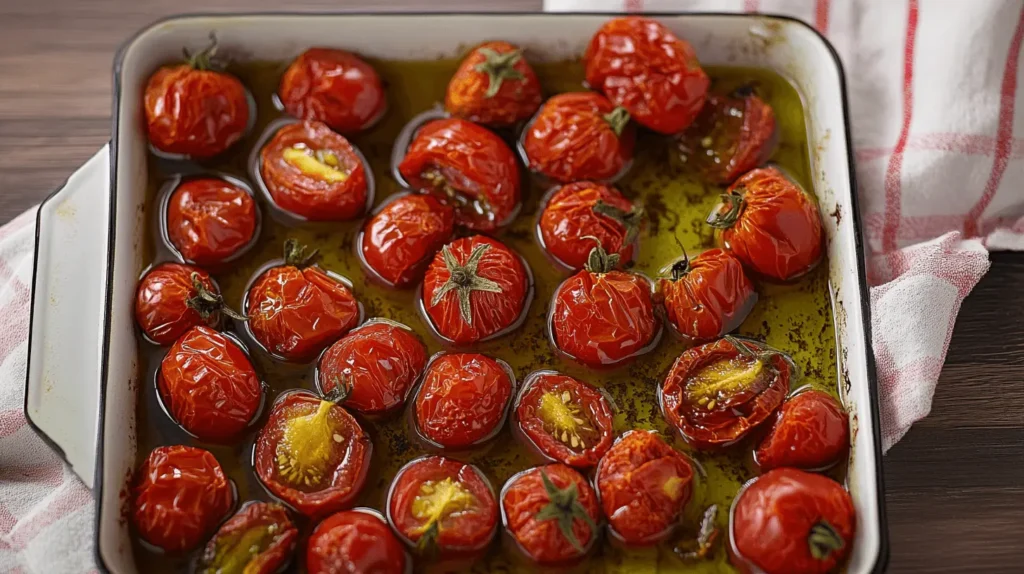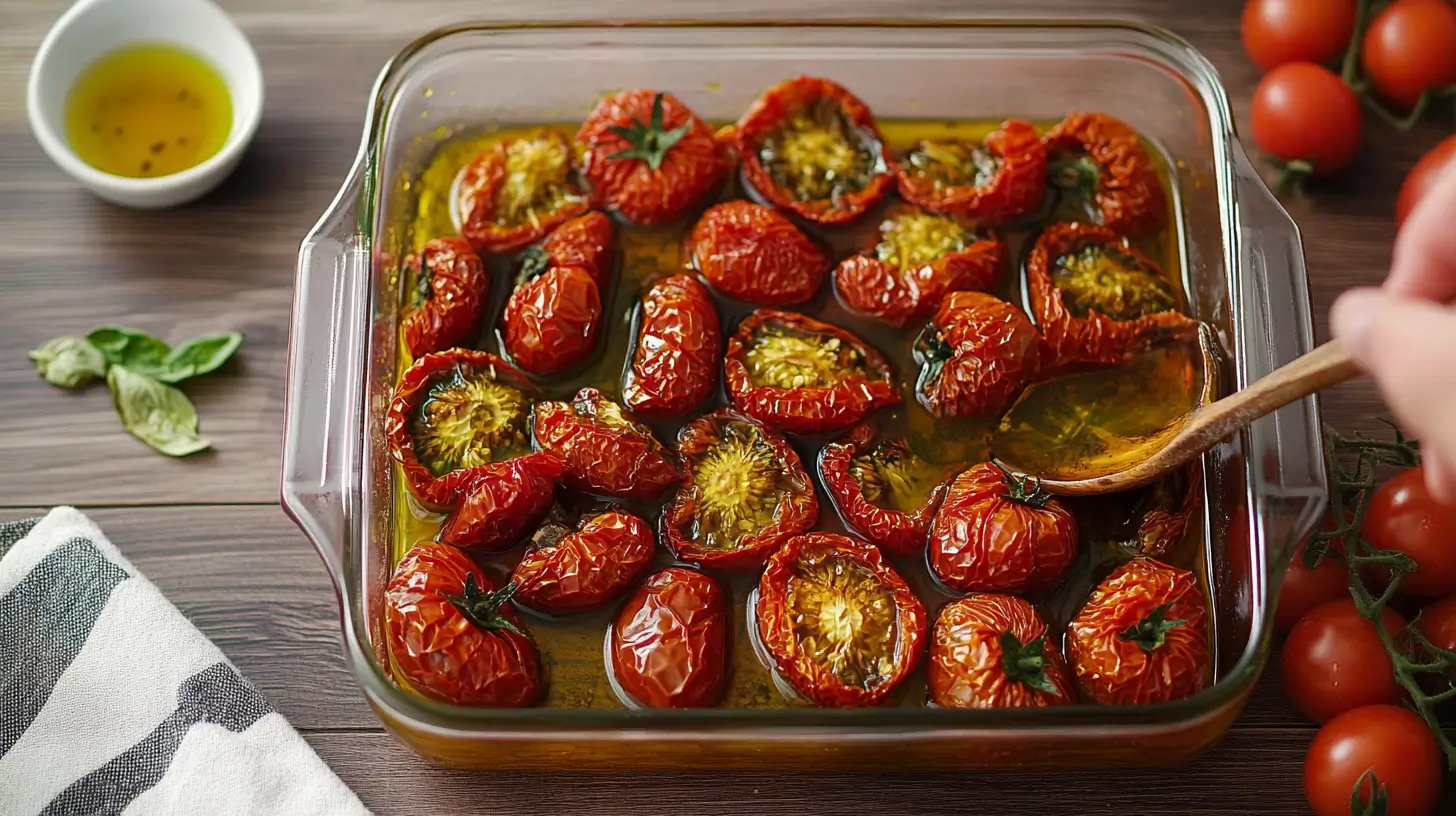Dried tomatoes in oil are a true culinary gem. Whether you’re a fan of Italian cuisine or simply enjoy bold, sun-kissed flavors, this timeless preservation method adds depth and richness to your pantry staples. But beyond their delightful taste, dried tomatoes preserved in oil are versatile, healthy, and cost-effective. This article dives deep into everything you need to know about making, storing, and using this delicious treat. From step-by-step preparation tips to creative recipe ideas, you’ll find everything you need to make dried tomatoes in oil a staple in your kitchen
What Are Dried Tomatoes in Oil?
At its core, dried tomatoes in oil are sun-dried or dehydrated tomatoes preserved in olive oil. This process not only locks in their robust flavor but also makes them tender and ready to use in recipes. Unlike fresh tomatoes, these dried versions have an intense, concentrated taste that elevates dishes like salads, pasta, and appetizers.

The History and Popularity of Sun-Dried and Oil-Preserved Tomatoes
The tradition of drying tomatoes dates back centuries, originating in Mediterranean countries where sun-drying was a practical way to preserve the summer harvest. Over time, this method evolved to include olive oil as a natural preservative, keeping the tomatoes soft and flavorful. Today, sun-dried tomatoes in oil are a pantry favorite for food lovers and chefs worldwide.
Why Choose Oil Preservation for Dried Tomatoes?
Preserving dried tomatoes in oil isn’t just about convenience—it’s also about taste and texture. The oil softens the dried fruit, enhancing its natural sweetness while infusing it with additional flavors like garlic, herbs, or spices. Moreover, this method is economical, especially if you grow your own tomatoes or buy them in bulk during peak season.
How to Prepare Dried Tomatoes for Oil Preservation
Essential Ingredients for Perfect Drying Tomatoes
- Tomatoes (preferably Roma or plum tomatoes) – The main ingredient for drying.
- Olive Oil – High-quality extra virgin olive oil for preservation and flavor infusion.
- Red Wine Vinegar (optional) – To increase acidity and enhance shelf life.
Optional Ingredients for Flavor
- Dried Herbs – Such as oregano, thyme, or rosemary, for a Mediterranean touch.
- Crushed Red Pepper Flakes – For a bit of spice.
- Salt – To enhance the natural flavors of the tomatoes.
What to Avoid
- Fresh Garlic or Herbs – While tempting for flavor, they can introduce moisture and increase the risk of botulism.
Selecting the Right Tomatoes for Drying
When making Drying Tomatoess in oil, the type of tomato you choose is essential. Plum tomatoes, such as Roma, are ideal due to their dense texture and lower water content. Heirloom varieties can also be used for unique flavors but may take longer to dry because of their juiciness. Ensure the tomatoes are fresh, firm, and free of blemishes for the best results.
Step-by-Step Guide to Drying Tomatoes
Dehydrators are a top choice for evenly drying tomatoes without overcooking them. Set your dehydrator to 135°F and dry the tomatoes until they feel leathery and bend without breaking. If you don’t have a dehydrator, an oven set at its lowest temperature (around 170°F) works too. Keep the oven door slightly ajar to allow moisture to escape.

Testing for Proper Dryness
Properly dried tomatoes should have a leathery texture, with no visible moisture when pressed. If some pieces feel crisp, don’t worry—they can still be used. Avoid under-drying, as leftover moisture can spoil the tomatoes during storage.
Safety Tips: Acid Dips and Preserving Flavor
To further reduce spoilage risk, dip the Drying Tomatoes in red wine or apple cider vinegar before placing them in oil. This increases acidity and enhances their shelf life while adding a subtle tang.
Storing Dried Tomatoes in Oil
Steps to Safely Store Dried Tomatoes in Olive Oil
Begin by sterilizing your storage jars to prevent contamination. Pack the dried tomatoes tightly, leaving some space at the top. Pour in enough high-quality olive oil to completely cover the tomatoes, ensuring no air pockets remain.
Avoiding Botulism and Ensuring Food Safety
While dried tomatoes in oil are a delicious addition to any pantry, safety is paramount. Never add fresh garlic or herbs directly to the jar, as this can create an anaerobic environment conducive to botulism. Store the jars in a cool, dark place, and refrigerate them once opened to maintain freshness.
Alternatives to Olive Oil for Preservation
Although olive oil is a classic choice, other oils like sunflower or avocado oil work as well. These oils provide unique flavor profiles but may not last as long. Choose oils with a high smoke point and neutral taste if experimenting.
Benefits of Dried Tomatoes in Oil
Health Benefits and Nutritional Value
Dried tomatoes in oil are more than a tasty treat; they’re a nutritional powerhouse. Packed with antioxidants like lycopene, they help fight free radicals and support overall health. These tomatoes are also rich in vitamins C, A, and K, along with potassium and dietary fiber. Adding them to your meals can boost heart health, enhance digestion, and support immune function.
Cost-Effectiveness Compared to Store-Bought Options
Homemade dried tomatoes in oil are a budget-friendly alternative to expensive store-bought jars. By drying tomatoes during their peak season, you save money and enjoy superior taste and freshness. Plus, you control the ingredients, ensuring a healthier option without unnecessary preservatives.
Flavors and Culinary Versatility
Few ingredients rival the depth of flavor that dried tomatoes in oil bring to dishes. Their rich, tangy, and slightly sweet profile complements a wide array of cuisines. For instance, they pair beautifully with Shrimp Spinach Pasta – Easy, Delicious, and Nutritious Recipe, adding an extra burst of flavor and Mediterranean flair. Whether tossed into pasta, incorporated into salads, or blended into dips, dried tomatoes elevate any meal with minimal effort.
Nutritional Table: Dried Tomatoes in Oil
| Nutrient | Amount per 100g | Daily Value (%) |
|---|---|---|
| Calories | 170 | 8% |
| Total Fat | 14g | 18% |
| Saturated Fat | 2g | 10% |
| Trans Fat | 0g | 0% |
| Cholesterol | 0mg | 0% |
| Sodium | 80mg | 3% |
| Total Carbohydrates | 10g | 4% |
| Dietary Fiber | 2g | 8% |
| Sugars | 6g | – |
| Protein | 2g | 4% |
| Vitamin A | 10% | – |
| Vitamin C | 15% | – |
| Calcium | 4% | – |
| Iron | 6% | – |
Culinary Uses for Dried Tomatoes in Oil
Salads, Pastas, and Sauces
Adding Drying Tomatoes in oil to fresh salads provides a burst of tangy sweetness, perfectly balancing greens and vinaigrettes. In pastas, they work wonders when paired with creamy sauces or pesto, offering a gourmet touch without much effort. And for sauces, blending these tomatoes creates a rich base that’s perfect for Italian or Mediterranean-inspired dishes.
Appetizers and Dips
Elevate your appetizers by using Drying Tomatoes in oil in crostini toppings or flatbreads. For a quick, crowd-pleasing dip, blend these tomatoes with cream cheese or hummus for a creamy, tangy spread.
Innovative Ways to Use Infused Olive Oil
The olive oil used to preserve the tomatoes is equally versatile. Drizzle it over roasted vegetables, use it as a salad dressing base, or mix it with herbs for a bread-dipping oil. Its rich, tomato-infused flavor is a culinary treasure that elevates any dish it touches.
Common Issues and Troubleshooting
What to Do if Tomatoes Are Too Hard or Too Soft
Sometimes, your Drying Tomatoes in oil might not have the perfect texture. If they’re too hard, rehydrating them briefly in warm water can soften them before use. For softer tomatoes, make sure they’re properly dried next time to prevent spoilage. Always aim for a leathery texture that bends without cracking or releasing moisture.
How to Revive Stored Dried Tomatoes
If your stored tomatoes become too stiff over time, the infused oil can work wonders. Remove a few tomatoes and let them soak in the oil at room temperature for a few hours. This not only softens them but also enriches their flavor.
Addressing Flavor or Texture Concerns
Occasionally, dried tomatoes in oil may taste overly acidic or bland. Adjust this by adding small amounts of dried herbs, chili flakes, or a sprinkle of salt directly into the jar. However, avoid adding fresh ingredients, as these could compromise the preservation process.
FAQs About Dried Tomatoes in Oil
How Long Will Dried Tomatoes Last in Olive Oil?
When stored correctly, Drying Tomatoes in oil can last up to a year in a cool, dark place. For opened jars, refrigeration is essential, and the tomatoes should be consumed within two to three weeks to ensure safety and optimal taste.
What Can You Do with Dried Tomatoes in Oil?
The versatility of Drying Tomatoes in oil makes them a must-have ingredient. They’re perfect for enhancing salads, pizzas, or pasta dishes. You can also blend them into spreads or add them to soups for a flavor-packed twist.
Are Dried Tomatoes in Oil Healthy?
Absolutely! These tomatoes are a rich source of vitamins and antioxidants, while the olive oil provides healthy fats. Together, they create a nutrient-dense ingredient that supports heart health and adds flavor without excessive calories.
Can You Rehydrate Dried Tomatoes in Oil?
Yes, you can. Although preserved in oil, they may sometimes need rehydration, especially if they’ve dried further during storage. Simply remove them from the oil and soak them in warm water for a few minutes to restore their pliability.
Conclusion and Final Tips
The Joy of Homemade Dried Tomatoes in Oil
Making your own Drying Tomatoes in oil is a rewarding experience. Not only do you save money, but you also enjoy the superior flavor and freshness that store-bought versions often lack. These tomatoes are a delicious and versatile addition to your pantry, ready to transform ordinary meals into gourmet creations.
Final Safety Reminders and Best Practices
To ensure the longevity and safety of your Drying Tomatoes in oil, always use clean, sterilized jars and high-quality olive oil. Avoid adding fresh herbs or garlic to prevent spoilage. Store unopened jars in a cool, dark place, and refrigerate opened ones promptly. By following these tips, you’ll enjoy your homemade tomatoes all year round.

